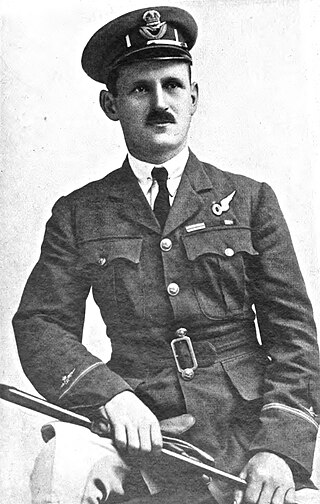Related Research Articles

Captain George Edward Henry McElroy MC & Two Bars, DFC & Bar was a leading Irish fighter pilot of the Royal Flying Corps and Royal Air Force during World War I. He was credited with 47 aerial victories.
William Frederick James Harvey DFC & Bar MC MBE was a British flying ace in World War I credited with twenty-six victories. He was the first recipient of the DFC & Bar and was also awarded the MC.
Captain Samuel Frederick Henry "Siffy" Thompson was a British World War I two-seater fighter ace who, in conjunction with his observer-gunners, was credited with thirty aerial victories before being shot down and killed. Despite having an active fighter career of only five months, he reached the rank of captain and won two British military decorations.
Captain Dennis Latimer was a British World War I flying ace notable for achieving twenty-eight aerial victories, all against enemy fighter aircraft.
Major Thomas Sinclair Harrison was a World War I fighter ace credited with 22 aerial victories. He was a balloon buster, as he destroyed two enemy observation balloons. This made him the fourth highest scoring South African.
Captain Walter Alfred Southey was a British First World War flying ace, credited with twenty aerial victories, including five balloons, making him the second highest scoring ace in No. 84 Squadron, behind Andrew Beauchamp-Proctor.
Captain Eric Guy Brookes was a British World War I flying ace credited with six aerial victories.
Captain John Todd (1899–1980) was a Scottish First World War flying ace credited with 18 aerial victories.
Captain George Everard Gibbons was a British World War I flying ace credited with 18 aerial victories gained while flying a Bristol F.2 Fighter in 1918. Both of his observers, Sidney Knights and Thomas Elliott, also became aces flying with him. Gibbons' final tally consisted of three enemy aircraft destroyed by fire, five others destroyed, and ten driven down out of control.
Sergeant Ernest Arthur Deighton was an English World War I observer/gunner flying ace credited with 15 confirmed aerial victories; all but one of them was against enemy fighters.
Captain Robert Alexander Birkbeck, was a British World War I flying ace credited with 10 aerial victories.
Captain Reginald Howard Rusby Distinguished Flying Cross|DFC was a World War I flying ace credited with ten aerial victories.
Lieutenant George Raby Riley was a British World War I flying ace credited with thirteen aerial victories. He was an ace balloon buster, as well as an ace over enemy aircraft.

Lieutenant Walter Noble was a World War I flying ace credited with twelve aerial victories.
Geoffrey Herbert Hooper was an Australian World War I flying ace credited with eleven aerial victories, all against German fighter planes.
Captain Solomon Clifford Joseph was a British flying ace of the Royal Naval Air Service during World War I. He was credited with thirteen confirmed aerial victories.
Lieutenant William Thomas Barnes was an English World War I flying ace. He served as an observer/gunner in Bristol F.2 Fighters, gaining, in conjunction with his pilots, nine confirmed aerial victories over German Fokker D.VII fighter planes. Post-war he served in the Royal Irish Constabulary and was killed in the Kilmichael ambush on 28 November 1920.
Captain William Stanley Jenkins was a Canadian flying ace during World War I. He was officially credited with 12 aerial victories, having scored his first two while still on sick leave.
Captain Adrian James Boswell Tonks was a British First World War flying ace. He was officially credited with twelve aerial victories, and was twice awarded the Distinguished Flying Cross.
Captain Frank Cecil Ransley was a British World War I flying ace credited with nine aerial victories. He would survive the war to become one of its oldest aces before dying at 95 years of age.
References
- Guttman, Jon (2007). Bristol F.2 Fighter Aces of World War I. ISBN 978-1846032011.